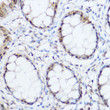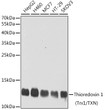| Post Translational Modifications | In the fully reduced protein, both Cys-69 and Cys-73 are nitrosylated in response to nitric oxide (NO). When two disulfide bonds are present in the protein, only Cys-73 is nitrosylated. Cys-73 can serve as donor for nitrosylation of target proteins. In case of infection, ubiquitinated by S.typhimurium protein slrP, leading to its degradation. |
| Function | Participates in various redox reactions through the reversible oxidation of its active center dithiol to a disulfide and catalyzes dithiol-disulfide exchange reactions. Plays a role in the reversible S-nitrosylation of cysteine residues in target proteins, and thereby contributes to the response to intracellular nitric oxide. Nitrosylates the active site Cys of CASP3 in response to nitric oxide (NO), and thereby inhibits caspase-3 activity. Induces the FOS/JUN AP-1 DNA-binding activity in ionizing radiation (IR) cells through its oxidation/reduction status and stimulates AP-1 transcriptional activity. ADF augments the expression of the interleukin-2 receptor TAC (IL2R/P55). |
| Protein Name | ThioredoxinTrxAtl-Derived FactorAdfSurface-Associated Sulphydryl ProteinSaspAllergen Hom S Trx |
| Database Links | Reactome: R-HSA-2559580Reactome: R-HSA-3299685Reactome: R-HSA-499943Reactome: R-HSA-5628897Reactome: R-HSA-5676934Reactome: R-HSA-844456Reactome: R-HSA-9617629Reactome: R-HSA-9660826Reactome: R-HSA-9818027 |
| Cellular Localisation | NucleusCytoplasmSecretedTranslocates From The Cytoplasm Into The Nucleus After Phorbol 12-Myristate 13-Acetate Induction (Pma)Predominantly In The Cytoplasm In Non Irradiated CellsRadiation Induces Translocation Of Trx From The Cytoplasm To The NucleusSecreted By A Leaderless Secretory Pathway |
| Alternative Antibody Names | Anti-Thioredoxin antibodyAnti-Trx antibodyAnti-Atl-Derived Factor antibodyAnti-Adf antibodyAnti-Surface-Associated Sulphydryl Protein antibodyAnti-Sasp antibodyAnti-Allergen Hom S Trx antibodyAnti-TXN antibodyAnti-TRDX antibodyAnti-TRX antibodyAnti-TRX1 antibody |
Information sourced from Uniprot.org










